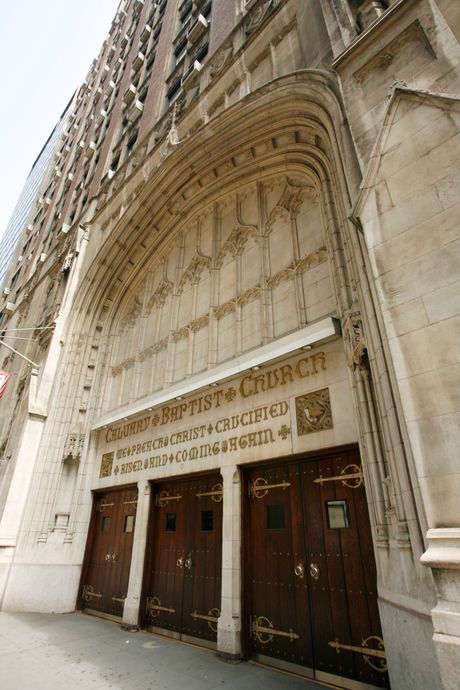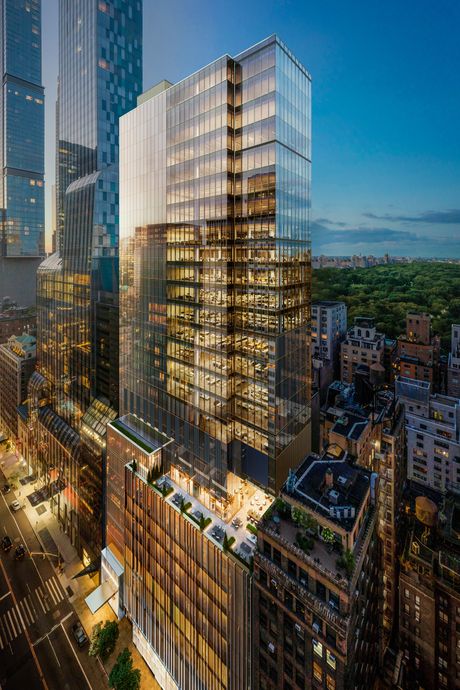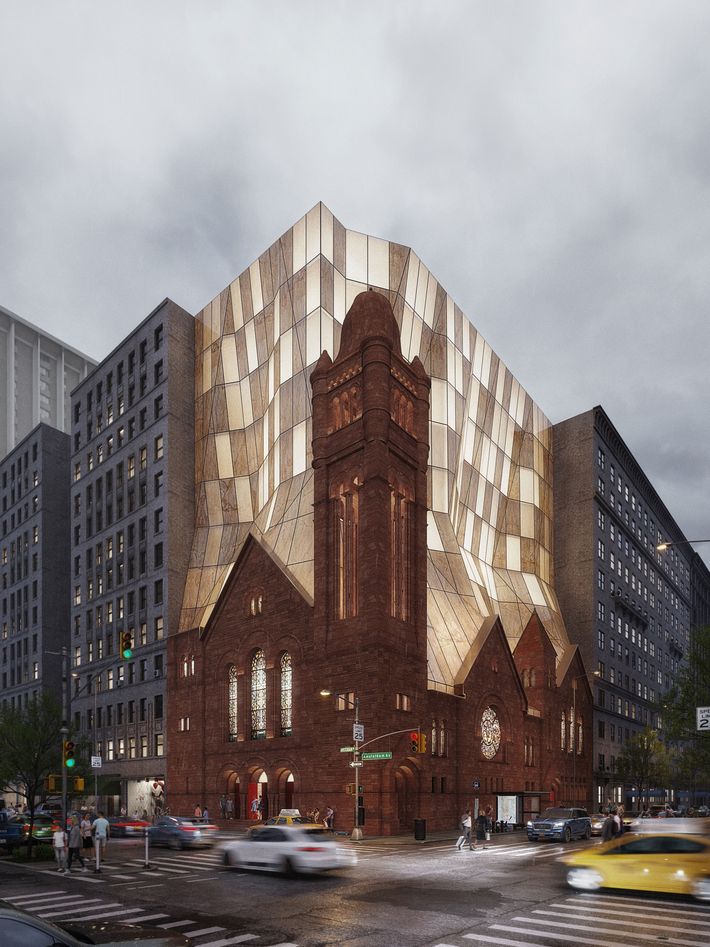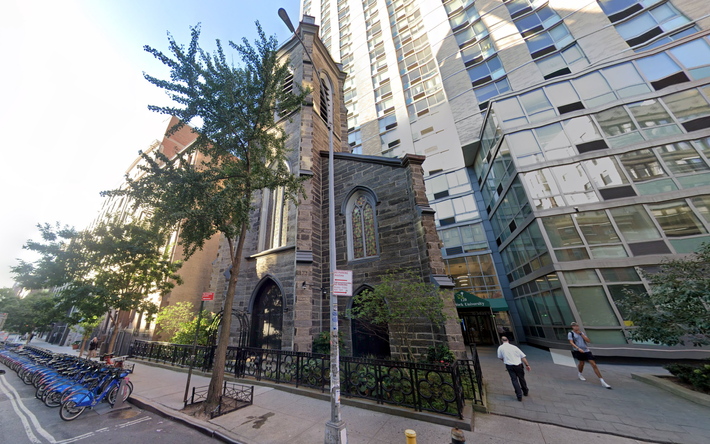Boston’s Holy Trinity German Church is now a condo building called the Lucas.
Photo: Raj Das
Another doomsday is on the horizon in the long-running demise of West-Park Presbyterian, the landmarked but dangerously dilapidated red-stone church on the corner of Amsterdam Avenue and West 86th Street. The church’s tenant, an arts presenter backed by a handful of celebrities, has been served with eviction papers. With the building soon to be vacant, the congregation skeletal, repairs prohibitive, and a developer waiting in the wings to tear it down, the building’s fate looks grim. Which is a shame, because there are alternatives to demolition, including one on display just a few blocks away.
Mount Pleasant Baptist Church on West 81st Street has just been reborn as a small condo building with a new sanctuary tucked behind the lobby. Architects at DXA Studio spent more than a decade shepherding their design through the Landmarks Preservation Commission, placating neighbors, and negotiating with the past. The result is a project that transformed a site of heavenly aspirations into one of earthly delight. From the street, Mount Pleasant looks untouched, only cleaner and less crumbly. At the back, neighbors can look out their kitchen windows and see a short stack of apartments in a peak-roofed greenhouse rise to the old turrets’ roofline and a double-height duplex. The addition is far more satisfying than just a glass box lurking behind a stone façade, because DXA interlocked old and new into an intricate puzzle. The street-facing towers remain; the bishop retains an apartment with tall, appropriately canonical arched windows and stained glass; and the other new residences have an appealing tinge of weirdness that new construction hardly ever offers. A design intermingled with existing architecture like this can’t be squeezed out of a tube; its hybridity is pure.
There’s a very long history of religious buildings sprouting inside previous structures or enfolding new ones: Churches in temples, museums in churches, and homes that take advantage of whatever deconsecrated walls they can. Those were frugal, pragmatic solutions; every stone that could be reused was another one that didn’t have to be quarried, cut, hauled, and placed. Today, the logic of construction begins with the clean slate, and the most expeditious way to convert vacant places of worship into living spaces is to clear away the old and start from scratch. But the increasingly obvious wastefulness of that approach has also bred a spate of marvelous mash-ups. The most straightforward way to reuse a church is to scoop out the interior, shore up the outer walls, and grow a new building inside. That’s what the firm Finegold Alexander did in Boston, inserting a glass-walled condo inside the neo-Gothic Holy Trinity German Church, so the new construction is veiled in stone filigree. The cynical version of this strategy is what NYU did with St. Ann’s on East 12th Street 20 years ago, demolishing the 1871 church designed by Napoleon LeBrun and replacing it with a high-rise dorm. As a sop to preservationists, the university salvaged the 1848 façade and tower, keeping them freestanding and pointless, like a souvenir on a shelf. A trickier — and richer — approach is to stitch old and new into a contemporary, fully wired space with a haunted-house vibe, as Perkins Eastman and Spector Group did for Audible’s headquarters in downtown Newark. The “Innovation Cathedral,” made up of a church, a parish house, and a community center, all sutured together, preserves a landmark, flatters a tech company’s sense of its own lofty calling, and creates workspaces with groin vaults, stained-glass windows (judiciously stripped of the most overt religious iconography), and a restored Tiffany laylight.
The converted Mount Pleasant Baptist, on West 81st Street. Clockwise from left: Photo: Wayne Norbeck/DXA StudioPhoto: Williams New YorkPhoto: Williams New York
The converted Mount Pleasant Baptist, on West 81st Street. From top: Photo: Wayne Norbeck/DXA StudioPhoto: Williams New YorkPhoto: Williams New York
Such conversions aren’t easy or straightforward. A church is not a warehouse — a big, sturdy, flexible space amenable to being carved up into modern living compartments. Instead, it’s usually a jumble of inefficiencies and idiosyncrasies, with oddly proportioned windows, ceiling heights that are either too high or too low, rooms that are vast or cramped, and, often, decades’ worth of untreated decay. Complexities compound when the church is a designated landmark, raising the cost of repairs and narrowing the options for renovation.
“Landmarking these buildings is the theoretical kiss of death for the congregations,” Ken Horn, CEO of the development company Alchemy, said in an interview with the real-estate publication Bisnow last year. “So the choice, to a certain degree, is edifice over congregation.” Of course, Horn has a vested interest in that point of view, since Alchemy has a contract to buy and demolish West-Park Presbyterian Church. There’s a catch: Before the sale can go through, the company wants the Landmarks Preservation Commission to de-designate the building so that it can be torn down.
The DXA proposal for West-Park Presbyterian that Curbed commissioned in 2022.
Art: DXA Studio
It’s always seemed to me that the case gives the public a dumb pair of options: Keep West-Park landmarked and let it slowly demolish itself through neglect, or remove the designation and watch crews demolish it quickly. Either way, the church goes up in a cloud of crimson dust. That’s why, in 2022, I asked DXA to try to figure out a way — three ways, actually — to preserve at least some of the structure and merge it with housing. That approach offers not just a third choice, but many, because there’s never only one possible design or one all-encompassing set of limitations. Adaptive reuse is creatively liberating.
Immigrants arrive in New York, cluster, migrate, and disperse. They take their food and customs with them and leave behind religious buildings like so much real-estate litter. (The generations of Jews who populated, then abandoned, the South Bronx scattered the area with so many disused synagogues that an amateur historian created a website in their memory.) When that happens, a building’s value as a spiritual crucible gets converted into monetary value. The faithful walk away; developers salivate. Collectively, New York’s plethora of semi-disused churches represents a trove of fallow square footage, the real-estate equivalent of sacks of cash tossed in a field. They’re a resource for the city, too: Knock them all down, and New York could theoretically make room for 98,000 more households, according to estimates by NYU’s Furman Center.
As the Catholic archdiocese hunts for ways to contract, it’s been shedding churches wholesale and having no trouble finding buyers that are tuned to the doings — or undoing — of religious organizations. Last year, Golani Development acquired Holy Rosary Church on East 119th Street, a handsome gray-stone neo-Romanesque durable beauty with a trio of pedimented portals and a great rose window. Golani, which has been building apartments in East Harlem for more than a decade, has filed plans to knock it down. It’s easy to understand why: The church no longer has the bodies to fill the pews or the money to keep the lights on, and the neighborhood needs housing. You might shrug that it’s a shame, but the logic is unassailable.
Audible’s “Innovation Cathedral” conversion in downtown Newark (then and now). Clockwise from left: Photo: Ben Gancsos/Courtesy SPECTOR companiesPhoto: Courtesy SPECTOR companiesPhoto: Ben Gancsos/Courtesy SPECTOR companies
Audible’s “Innovation Cathedral” conversion in downtown Newark (then and now). From top: Photo: Ben Gancsos/Courtesy SPECTOR companiesPhoto:…
Audible’s “Innovation Cathedral” conversion in downtown Newark (then and now). From top: Photo: Ben Gancsos/Courtesy SPECTOR companiesPhoto: Ben Gancsos/Courtesy SPECTOR companiesPhoto: Courtesy SPECTOR companies
Even spiritually minded organizations are tempted to realize the potential fortunes they’re sitting on. Calvary Baptist Church had its headquarters and a sanctuary in a 1931 16-story high-rise on West 57th Street that included the Salisbury Hotel. It’s more office building than church, though the Gothic portal harmonized with the finials and turrets on top. But this is Billionaires’ Row, where a square foot costs roughly the same as an ounce of gold. The institution took the cash and will stay at the same address, in a replacement space within a new 30-story glass tower by FX Collaborative.


Before and after: Calvary Baptist’s office-and-church building on West 57th and the tower that replaced it. From left: Photo: Najlah Feanny/Corbis via Getty ImagesPhoto: Neoscape
Before and after: Calvary Baptist’s office-and-church building on West 57th and the tower that replaced it. From top: Photo: Najlah Feanny/Corbis via …
Before and after: Calvary Baptist’s office-and-church building on West 57th and the tower that replaced it. From top: Photo: Najlah Feanny/Corbis via Getty ImagesPhoto: Neoscape
All this is hardly a tragedy for shrinking congregations and the umbrella organizations they belong to, which often see little but sentimental value in buildings that are merely stone-and-stained-glass receptacles for spiritual striving. The wine is not the bottle. But if you’re looking from the outside, the container matters more than what’s contained. Churches, synagogues, temples, mosques — these worldly shells stand as evidence of New York’s long history of diversity and change. Factories outlive their products, warehouses their storage purposes, printing plants their publications, and houses of worship their congregations. We should begin from the premise that, where possible, obsolete structures can be recycled or repurposed, not treated as building-shaped stacks of rubble. At the very least, the environmental cost of demolition and new construction needs to be incorporated into the developer’s math.
The cautionary tale: NYU’s sad little preserved façade on East 12th Street.
Photo: Google Maps
Not every disused house of worship is worth keeping just because it exists and it’s old. And developers who take on the spatial complexities of working with old architecture face a dismaying array of bureaucratic and financial challenges. But a recent change to the zoning code might have shaken loose a few more options for preservation. Owners of landmarked buildings have long been able to transfer — that is, sell — air rights to adjacent lots, once the proposal had passed through the slow and expensive public review process. Now they can transfer those rights farther afield — down the block or across the street — and navigate a different, much speedier approvals gauntlet. That technical change increases the likelihood that a congregation of a tumbledown church might raise the money to unlock more housing and at the same time fix up their building — without simply selling it for scrap.



